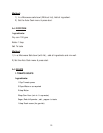
UTENSILS GUIDELINE
It is strongly recommended to use the containers which are suitable and safe for microwave cooking.
Generally speaking, the containers which are made of heat-resistant ceramic, glass or plastic are suitable
for microwave cooking. Never use the metal containers for microwave cooking and combination cooking
as spark is likely to occur. You can take the reference of below table.
Material of container microwave Grill Combi Notes
Heat-resistant ceramic Yes No No Never use the ceramics which are
decorated with metal rim or glazed
Heat-resistant plastic Yes No No Can not be used for long time microwa
v
cooking
Heat-resistant glass Yes No No
Grill rack No Yes Yes
Plastic film Yes No No It should not be used when cooking meat
or chops as overtemperature may do
damage to the film
FOR THE FIRST USE
As there is manufacturing residue or oil remained on the oven cavity or heat element, it usually would
smell the odor, even a slight smoke, It is normal case and would not occur after several times use, keep
the door or window open to ensure good ventilation. So it is strongly recommended to set the oven to grill
mode and operate dry several times.Operating dry can only be conducted in the grill mode, it can not be
conducted at combination mode
IMPORTANT SAFEGUARDS
The following basic precautions should always be followed when using electrical appliance:
1. Read all instructions before using.
2. Make sure the voltage in your living area corresponding to the one shown on the rating label of the
appliance. And the wall socket is properly grounded.
3. To reduce the risk of fire in the oven cavity:
a. Do not overcook the food.
b. Remove wire twist-ties from paper or plastic bags before placing bags in the oven.
c. Do not heat oil or fat for deep drying as the temperature of oil cannot be controlled.
d. After use wipe the waveguide cover with a damp cloth, followed by dry cloth to remove any food
splashes and grease. Built-up grease may overheat and begin to cause smoke or catch fire.
e. If materials inside the oven should smoke or ignite, keep oven door closed, turn oven off and
disconnect the power supply.
f. Close supervision is necessary when using disposable containers made from plastic, paper or other
combustible material.
4. To reduce the risk of explosion and sudden boiling:
a. Do not place sealed containers in the oven. Baby bottles fitted with a screw cap or teat are considered
to be sealed containers.
b. When boiling liquid in the oven, use the wide-mouthed container and stand about 20 seconds at the
end of cooking to avoid delayed eruptive boiling of liquids.
c. Potatoes, sausage and chestnut should be peeled or pierced before cooking. Eggs in their shell, whole
hard-boiled eggs should not be heated in microwave ovens since they may explode, even after
microwave heating has ended.
2


















